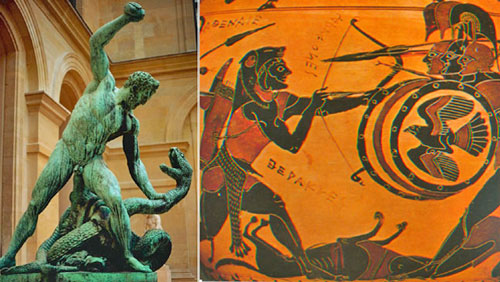|

Oct 21, 2004

Of all the ancient heroes, none achieved greater popularity than the
Greek Heracles, (Roman Hercules), son of
Zeus. The sculpture on the
left above depicts Hercules’ defeat of the serpent-monster
Achelous,
and the archaic Greek vase painting on the right portrays the hero’s
defeat of the three-headed monster Geryon.
We have already noted that, across the centuries, former celestial
gods were brought down to earth through storytelling, presenting an
enigma for the chroniclers. How would later poets and historians
describe the thunderbolt with which, in the more archaic tales, the
warrior-god vanquished heaven-spanning serpents, dragons, or chaos
monsters?
In some cases the electrical character of the weapon simply
disappeared. But in an astonishing number of instances, the
lightning connection was preserved either through metaphor, or
etymologies. Just as the spear of Achilles retained the connection
to the thunderbolt of Zeus (it "flashed lightning round"), the poet
Hesiod describes Heracles leaping into battle "like the lightning of
his father Zeus".
The hero’s connection to the "thunderbolts of the gods" was no
accident, a fact confirmed by cross-cultural comparison. In the
Grail cycle of myths, lightning receives the name
Lanceor, or
"Golden Lance", an archaic name of Lancelot.
Lightning is also
linked to the sword Excalibur, which Geoffrey of Monmouth called
Caliburn, from the Welsh Caledvwich, Irish
Caladbolg: old names for
the "lightning".
The most famous Celtic hero, Cúchulainn, victor over chaos powers,
held a weapon granted him by the lightning-god Bolga, "the inventor
of the missile spear". The words Gaé Bolga signify
Bolga’s spear, an
acknowledged "lightning weapon" forged by the divine smith (like the
thunderbolt of Zeus) in the Otherworld. So too, the warrior
Fergus,
when wielding his sword In Caladbolg, could single-handedly slay
hundreds on the battle field. The sword’s name means "a two-handed
lightning sword".
Again and again, Germanic tribes placed the thunderbolt in the hands
of their celebrated heroes. Here, according to H. Bächtold-Stäubli,
the forms of the thunderbolt ranged from "the rough stone and the
club of primitive times through hammer, axe, and spear to the golden
sword wielded by the Hero". (We take up the most famous Germanic
thundergod Thor in pictures to follow.)
Gertrude Jobes, a diligent investigator of symbolic themes, affirms
that, among the Altaic Tatars, lightning was the "arrow of a mighty
hero". A common Slavic name for the weapon of the celestial warrior
Perun is strela, "arrow". The Finnish warrior-hero
Jumala, is said
to have "wielded thunderbolts in the shape of jagged
lightning-spears".
For the Hindus, it was the great warrior Indra who defeated the
dragon Vritra with his thunderbolt. Among the
Tibetans and Mongols lightning was the arrow of a dragon-riding god, and thunder was the
voice of the dragon. In the same way, the warrior Raiden, in
Japanese myth, wielded "fire-arrows" - identified as the
thunderbolt - in his battle against the chaos power,
Raiju, the
"Thunder-beast".
Numerous equations of hero’s weapon and thunderbolts occur in
the
Americas as well. Iroquois account tells of a warrior
Hé-no, whose
name means "thunder".
"A monstrous serpent dwelt under the village,
and made his annual repast upon the bodies of the dead which were
buried by its side. He went forth once a year, and poisoned the
waters of the Niagara, and also of the Cayuga creek, whereby the
pestilence was created. Hé-no discharged upon the monster a terrific
thunderbolt which inflicted a mortal wound."
Similarly, the Navaho say that long ago the arrows that defeated the
devouring powers of chaos were the lightning. The Pawnee and their
neighbors recall the great warrior, named Black Lightning Arrow.
Thus, Von del Chamberain, who ranks among the most informed
authorities on Plains Indian mythology, tells us that "the flint-
tipped arrows of the Indian correspond to the lightning arrows shot
to earth by higher powers".
EDITORS’ NOTE: Thanks to the linguist Rens van der Sluijs for
several of the references in the present discussion.
|
